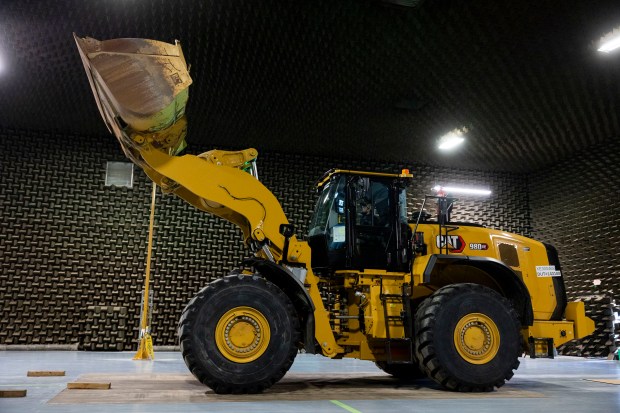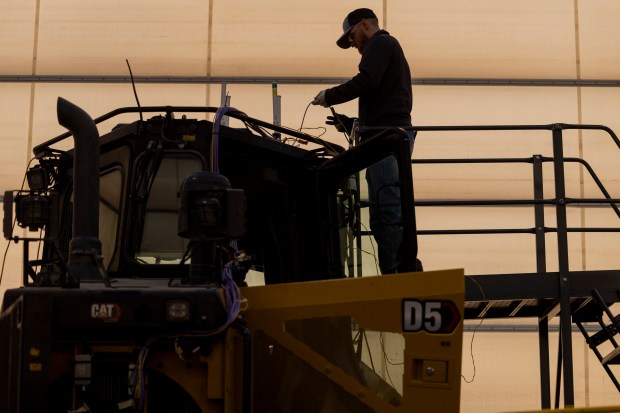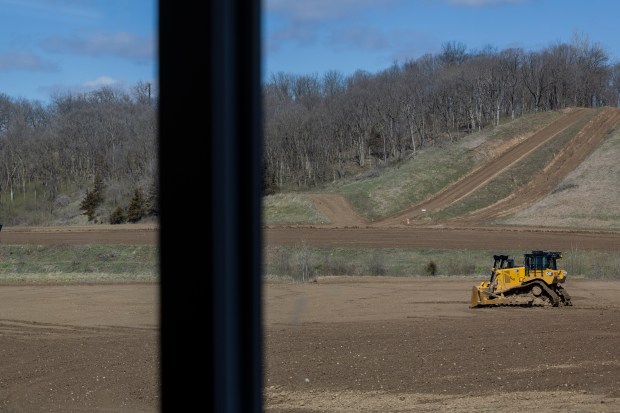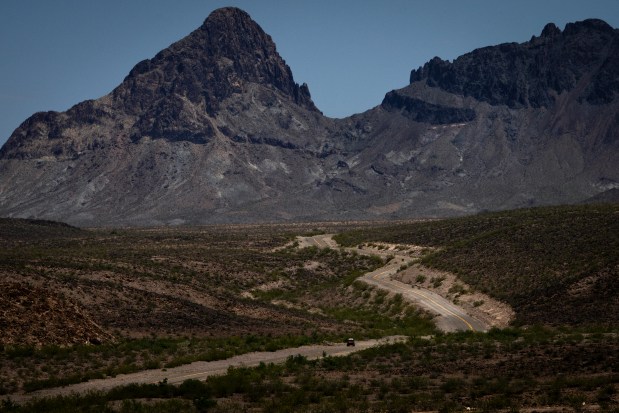Grounded in central Illinois throughout its century-long history, heavy equipment manufacturer Caterpillar has seemingly been smitten by corporate wanderlust of late, moving its headquarters from Peoria to Deerfield to Irving, Texas, over the past seven years.
But Caterpillar remains deeply rooted in the Peoria area with 12,000 employees, a major manufacturing operation and something few visitors have ever seen: a secluded 2,500-acre site where the company is carving a path to the future.
For more than 75 years, the Peoria Proving Ground has been the secret place where giant yellow earthmoving machines are tested, refined and readied to do the heavy lifting. Set back amid steep ravines, dense woods and winding roads in the nearby town of Washington, it is the company’s muddy nexus of innovation, where a number of industry-leading products were introduced to the world.
“We’re really proud of our history and the things that we’ve contributed to this company over the years,” said Charlie Menke, director of machine development for Peoria Proving Ground. “The high drive track-type tractor was developed at this facility. The first electric drive track-type tractor was developed at this facility. We’re currently working on additional electric drive machines.”
How new equipment plays in Peoria, a bustling and historic city along the Illinois River, can move mountains around the world.
From massive electric drive bulldozers to autonomous tractors, 400 employees put the cutting-edge machines through their paces, testing sound levels, top speeds and remote control operations that make plowing the earth akin to a video game.
Launched in 1948, the sprawling facility is part nature preserve, part perpetual construction site.
The grounds feature test tracks, steep climbs designed to see what happens when a tractor tumbles blade over backhoe, and excavation areas where machines move piles of dirt back and forth from one side to the other in a Sisyphean task.
Fun fact: A Cat motor grader can hit 32 mph on the Proving Ground’s oval test track, Menke said.
The main compound includes a 50,000-square-foot repair shop, an industrial-strength car wash to spray gobs of mud off the field-tested equipment and a cavernous acoustic room that could serve as a recording studio, but instead measures a symphony of noises emanating from the giant machines.
“We test for regulation purposes, for diagnostic purposes,” said test engineer Colin Mitchell, firing up a 67,000-pound 980 XE wheel loader, its roar dampened by the sound tiles lining the walls. “We can test individual components in the machine to figure out if they are making noises that they shouldn’t.”

In another building, engineers wire up sensors to a Cat D5 bulldozer to take transmitted readings as it operates in the field, a sort of tractor electrocardiogram. Nearby sits the pride of Peoria, a hulking D11XE, a prototype of the first electric drive mining tractor.
The D11 mining tractor, the largest bulldozer Caterpillar makes, is built exclusively at its East Peoria factory. Launched in 1986, the 230,000-pound behemoth is a mainstay in mining and large construction projects. In October, the 6,000th D11 rolled off the production line, bound for an Australian customer site.
Founded nearly a century ago in Peoria with the 1925 merger of the Holt and Best tractor companies, Caterpillar and its bright yellow machines became an international powerhouse, building roads, bridges and dams around the world.
Long one of the largest companies in Illinois, Caterpillar generated $67 billion in revenues last year, up 13% over 2022, according to its annual report. The company has more than 113,000 employees worldwide, including nearly 18,000 in Illinois. In addition to East Peoria, Caterpillar has a major factory in Decatur that builds its large mining trucks, among other products.
While Caterpillar equipment has been everywhere from Antarctica to the moon, the company has always been inextricably linked with its Peoria home. But in 2017, citing proximity to O’Hare International Airport and Chicago, Caterpillar relocated its corporate headquarters to north suburban Deerfield, taking over the vacated offices of premium spirits maker Beam Suntory, which moved to Chicago.

Caterpillar also opened a digital office in Chicago in 2016, now located in the West Loop, where a team of software developers, data analysts and computer engineers work on everything from e-commerce solutions to apps used for equipment maintenance and monitoring.
In 2022, as companies began downsizing offices and shedding massive campuses in the wake of the pandemic, Caterpillar moved its corporate headquarters again, consolidating operations at an existing office in Irving, Texas, near an electric power division it established the previous year.
At the time, Caterpillar Chairman and CEO Jim Umpleby said the decision to relocate the C-suite and several hundred employees to Texas was “in the best strategic interest of the company,” but offered few reasons publicly to support it.
The company declined further comment on the corporate relocation for this story. But Peoria and the Proving Ground remain central to Caterpillar’s future.
Part of that future is housed in a trailer down twisting dirt roads, far from the main facility, where autonomous technology — operating tractors by remote control — is being refined, and beginning to gain traction among customers.
Caterpillar, which began experimenting with autonomous construction equipment nearly a decade ago, is one of several major companies developing it, along with Doosan in South Korea and Volvo Autonomous Solutions, which unveiled its new Swedish testing site in November. The potentially transformative technology is still in the early stages of commercialization.
At the Peoria Proving Ground’s autonomous test site, a row of remote operating stations line a picture window overlooking a barren field, where a lone Cat D7 bulldozer sits waiting to receive internet instructions over an array of Wi-Fi access points.

The operating stations resemble an arcade game, featuring a chair with joysticks at either arm, a shifter, foot brakes and multiple video screens with a Cat’s-eye view of the field. The tractor can plow a preprogrammed course, be operated manually or both. When the tractor flashes a blue light and honks in response, a quick shift into drive, and it’s off.
Fixing on a screen, it’s easy to forget that the joysticks are piloting a 66,000-pound bulldozer digging up dirt and spinning on a dime in the field beyond. The technology can be used to operate tractors 1,500 feet or 1,500 miles or farther from the operating stations — anywhere an internet signal can be received.
“We’ve operated machines in Malaga (Spain) from here before,” said Tim Pennington, a test operator.
The remote stations solve a number of problems, including navigating dangerous terrain without putting the operator at physical risk. In addition, they can compensate for a dearth of qualified operators, allowing one person to control multiple machines at a work site, Pennington said.
The technology has even helped lure some retired bulldozer operators back into the saddle, Pennington said.
“The average dozer operator lasts until their mid-40s, and then their back is shot,” Pennington said. “With this, they’ve come out of retirement.”
While a Caterpillar spokesperson didn’t disclose sales figures, Pennington said “quite a few” larger customers have adopted the remote control technology, despite the challenge of getting Wi-Fi signals into some places, such as underground mines.
The technology hit a dead spot in the testing field during a recent trial run, where after minutes of being stuck, a separate handheld radio signal reached and moved the tractor just before Pennington was set to trudge across the muddy field to retrieve it by hand.

Once back in range of the Wi-Fi signal, the blue light began flashing and the tractor nimbly responded to joystick commands.
While the autonomous tractor continues to be perfected at the Peoria Proving Ground, its technology is perhaps a fitting metaphor for the company itself. For 12,000 employees and the Peoria region, the heart of Caterpillar’s manufacturing operation remains in central Illinois, but the corporate levers are now being pulled 800 miles away in Texas.
Menke, a 34-year Caterpillar veteran who has spent the last 13½ years at the Peoria Proving Ground, believes the value of the remote testing site is no secret.
“Solving problems,” Menke said. “That’s what we do.”




